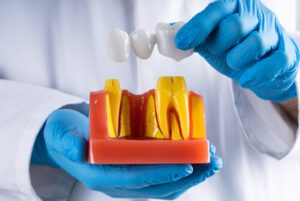Have you ever wondered how dentists restore a natural-looking smile after tooth loss? Whether you’ve lost one tooth or a few, you’ve probably heard your dentist mention something called a dental bridge. But what is a bridge in dental work, and how does it really work to bring your smile back to life?
This blog will walk you through everything you need to know about dental bridges, from how they work to the different types, the process, and what to expect.
Why Do We Need Dental Bridges?
Losing a tooth isn’t just about appearance. A missing tooth or multiple teeth can interfere with the way your bite functions, cause neighbouring teeth to shift, and make chewing or speaking difficult. If left untreated, it can also lead to bone loss in the jaw and further complications with your oral health.
That’s where dental bridges come in. A dental bridge restores the space left by one or more missing teeth by placing a false tooth (known as a pontic), which is supported by abutment teeth or dental implants. In simpler terms, it bridges the space left by the missing tooth, restoring both function and appearance.
So, What Is a Bridge in Dental Work?
 A dental bridge is a customised prosthetic designed to replace one or more missing teeth. It securely spans the gap by connecting to natural teeth or dental implants on either side. A typical dental bridge consists of:
A dental bridge is a customised prosthetic designed to replace one or more missing teeth. It securely spans the gap by connecting to natural teeth or dental implants on either side. A typical dental bridge consists of:
- Pontic – the artificial tooth that substitutes for the missing one
- Abutment tooth or teeth – the supporting teeth on either side of the gap
- Dental crowns – placed over the adjacent teeth or implants to hold the bridge securely
Depending on the type of bridge used, the anchoring methods and materials may vary.
Types of Dental Bridges: Which One Is Right for You?
Not all dental bridges are created equal. The type of bridge your dentist recommends depends on your dental health, the location of the gap, and the supporting teeth available. Let’s break down the most common types of dental bridges.
1. Traditional Dental Bridges
This is the most widely used type. Traditional bridges work by placing dental crowns over the teeth on either side of the gap to support the false tooth in between. These crowns support the false tooth in the middle.
- Best for: Patients with healthy adjacent teeth on both sides of the gap.
- Material: Usually porcelain fused to metal or ceramic.
- Note: Requires removal of some enamel from existing teeth.
2. Implant-Supported Bridges
If natural teeth are not available to support the bridge, dental implants can be used instead. In this case, implant-supported bridges are anchored directly to artificial roots that are surgically placed in the jawbone.
- Best for: Replacing multiple missing teeth, or if no healthy teeth are next to the gap.
- Pros: Long-lasting, strong, and prevents bone loss.
- Cons: Requires a more complex and lengthy procedure.
What Happens During the Dental Bridge Procedure?
Let’s take a look at what you can expect if you decide to move forward with a dental bridge.
Step 1: Initial Consultation
Your dentist will evaluate your oral health, understand your treatment goals, and determine the most appropriate type of dental bridge to suit your individual needs. They may take X-rays or digital scans to examine the surrounding teeth and jawbone. If any problems, such as gum disease or tooth decay, are found, these will need to be treated first.
Step 2: Tooth Preparation
In the case of a traditional bridge, the teeth on either side of the gap are carefully reshaped to make room for dental crowns, which will serve as anchors for the bridge. In practices that offer same-day crowns using CAD/CAM technology, digital impressions are taken, and your custom bridge is designed, milled, and placed all in one visit, eliminating the need for temporary crowns or multiple appointments.
Step 3: Placing the Bridge
When your permanent bridge is ready, your dentist will ensure it fits properly, make any needed adjustments, and then bond it in place using dental cement. You’ll leave the clinic with your final bridge in place, fully functional and matched to your natural bite and smile.
How Many Teeth Can a Bridge Replace?
A dental bridge can replace a single missing tooth or multiple teeth in a row. The number of teeth it can restore depends on the condition of the abutment teeth or how many implants are available to support the bridge.
Caring for Your Dental Bridge
Like natural teeth, dental bridges need proper care to last. With proper oral care, a dental bridge can last between 5 and 15 years and, in some cases, even longer.
Tips for maintenance:
- Brush twice daily using fluoride toothpaste.
- Floss under the bridge to clean the gum line.
- Use a floss threader or water flosser for hard-to-reach spots.
- Keep up with routine dental visits for checkups and professional cleans to support the longevity of your bridge and protect your overall oral health.
- Avoid biting down on hard objects to protect your false teeth.
Dental Bridge Cost: What Should You Expect?
The dental bridge cost varies depending on:
- The type of bridge you choose: traditional bridge vs implant-supported bridge
- Number of missing teeth: More teeth generally increase the cost of materials and lab work.
- Materials used: Bridges can be made from porcelain, metal alloys, or a combination. Porcelain fused to metal is common but may cost more than all-metal options.
- Location of the clinic: Dental fees can differ across cities and regions in Australia.
- The complexity of the case: Additional dental work like treating gum disease, tooth decay, or building up abutment teeth can increase the total cost.
- Laboratory and technician fees: Custom-made bridges crafted in premium dental labs may attract higher charges.
- Dentist’s experience: Highly skilled providers may charge more for their services.
In Australia, a traditional dental bridge to replace one tooth may start from $3,000. Implant-supported bridges can cost significantly more due to surgical steps and multiple components.
Some dental insurance plans or health funds may cover part of the cost, so be sure to check your policy.
Dental Bridge vs Partial Denture: What’s the Difference?
If you’re considering solutions to replace missing teeth, you might be curious about how a dental bridge stacks up against a partial denture.
- Dental Bridge: Fixed in place, more natural in feel, does not need to be removed.
- Partial Denture: Removable, often more affordable, may feel bulkier in the mouth.
The right choice depends on your budget, oral condition, and personal preference.
Are Dental Bridges Right for Everyone?
While dental bridges are a great solution for many people dealing with missing teeth, they may not be suitable for everyone. Your dentist will assess several factors to determine if a bridge is the right option for your smile and oral health.
Here’s what makes someone a good candidate:
- Healthy adjacent teeth or implants: A bridge relies on abutment teeth or dental implants for support. These supporting teeth need to be strong and free from decay or infection.
- Good oral hygiene habits: Brushing and flossing every day, along with routine dental checkups, are the foundation for keeping your bridge in good condition and avoiding issues like tooth decay or gum disease.
- No advanced gum disease: Healthy gums and bone structures are necessary to support a stable bridge. If you have periodontal issues, they’ll need to be addressed first.
- Missing one or more teeth in a row: Bridges work best when the gap involves one or more missing teeth positioned next to each other. They’re a suitable option when dental implants aren’t preferred or feasible.
- Commitment to care and maintenance: A bridge is a fixed, long-term solution, but it still needs care. You must be willing to look after both the bridge and the remaining teeth to ensure lasting results.
If you’re unsure whether a dental bridge or another option, like dental implants or partial dentures is best for you, your dentist can walk you through the advantages and drawbacks of each option, helping you choose what’s best for your unique situation.
FAQs About Dental Bridges
- How long do dental bridges last?
With proper care, dental bridges typically last between 5 to 15 years or more.
- Is a dental bridge painful?
The procedure is comfortable as local anaesthesia is used. Some sensitivity may occur after placement, but it usually settles quickly.
- Can I eat normally with a dental bridge?
Yes, you can. It’s best to begin with soft foods after placement and slowly ease back into your regular diet as you adjust.
- What happens if I don’t replace a missing tooth?
Other teeth may shift, your bite may change, and your risk for jawbone loss increases over time.
- Are dental bridges better than implants?
Not necessarily. Dental implants are more durable and preserve jawbone health, but bridges are quicker and more cost-effective.
Final Thoughts: A Bridge to a Better Smile
 Now that you know what a bridge in dental work is, it’s easy to see why they are such a trusted method for replacing missing teeth. Whether you’re missing a single tooth or multiple teeth, a dental bridge provides a stable, long-term solution that restores your smile’s function and boosts your confidence.
Now that you know what a bridge in dental work is, it’s easy to see why they are such a trusted method for replacing missing teeth. Whether you’re missing a single tooth or multiple teeth, a dental bridge provides a stable, long-term solution that restores your smile’s function and boosts your confidence.
They integrate naturally with your existing teeth, support the alignment of your remaining teeth, and can enhance both speech and chewing ability. Plus, with options like implant-supported bridges, there’s something suitable for almost every situation.
If you’re ready to explore your options for a false tooth solution that doesn’t compromise your lifestyle or smile, a dental bridge might be the right path forward. Book a dental appointment with Definitive Dental at (02) 6105 9833 and let a professional guide you through the whole process.
Note: Any surgical or invasive procedure carries risks. Before proceeding, you should seek a second opinion from an appropriately qualified health practitioner.
References
- Cleveland Clinic. (n.d.). Dental bridges. https://my.clevelandclinic.org/health/treatments/10921-dental-bridges
- Healthline. (n.d.). Dental anesthesia: What you need to know. https://www.healthline.com/health/dental-and-oral-health/dental-anesthesia
- NHS. (n.d.). Take care of your teeth and gums. https://www.nhs.uk/live-well/healthy-teeth-and-gums/take-care-of-your-teeth-and-gums/
- Priest, G. (1995). Single-tooth implants and their role in preserving remaining teeth: A 10-year survival study. International Journal of Prosthodontics, 8(6), 523–528. https://pubmed.ncbi.nlm.nih.gov/7578781/

